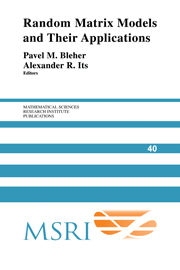Book contents
- Frontmatter
- Contents
- Preface
- Symmetrized Random Permutations
- Hankel Determinants as Fredholm Determinants
- Universality and Scaling of Zeros on Symplectic Manifolds
- z-Measures on Partitions, Robinson-Schensted-Knuth Correspondence, and β = 2 Random Matrix Ensembles
- Phase Transitions and Random Matrices
- Matrix Model Combinatorics: Applications to Folding and Coloring
- Interrelationships Between Orthogonal, Unitary and Symplectic Matrix Ensembles
- Dual Isomonodromic Tau Functions and Determinants of Integrable Fredholm Operators
- Functional Equations and Electrostatic Models for Orthogonal Polynomials
- Random Words, Toeplitz Determinants, and Integrable Systems I
- Random Permutations and the Discrete Bessel Kernel
- Solvable Matrix Models
- The τ-Function for Analytic Curves
- Integration over Angular Variables for Two Coupled Matrices
- Integrable Lattices: Random Matrices and Random Permutations
- SL(2) and z-Measures
- Some Matrix Integrals Related to Knots and Links
z-Measures on Partitions, Robinson-Schensted-Knuth Correspondence, and β = 2 Random Matrix Ensembles
Published online by Cambridge University Press: 25 June 2025
- Frontmatter
- Contents
- Preface
- Symmetrized Random Permutations
- Hankel Determinants as Fredholm Determinants
- Universality and Scaling of Zeros on Symplectic Manifolds
- z-Measures on Partitions, Robinson-Schensted-Knuth Correspondence, and β = 2 Random Matrix Ensembles
- Phase Transitions and Random Matrices
- Matrix Model Combinatorics: Applications to Folding and Coloring
- Interrelationships Between Orthogonal, Unitary and Symplectic Matrix Ensembles
- Dual Isomonodromic Tau Functions and Determinants of Integrable Fredholm Operators
- Functional Equations and Electrostatic Models for Orthogonal Polynomials
- Random Words, Toeplitz Determinants, and Integrable Systems I
- Random Permutations and the Discrete Bessel Kernel
- Solvable Matrix Models
- The τ-Function for Analytic Curves
- Integration over Angular Variables for Two Coupled Matrices
- Integrable Lattices: Random Matrices and Random Permutations
- SL(2) and z-Measures
- Some Matrix Integrals Related to Knots and Links
Summary
We suggest a hierarchy of all the results known so far about the connection of the asymptotics of combinatorial or representation theoretic problems with “β = 2 ensembles” arising in the random matrix theory. We show that all such results are, essentially, degenerations of one general situation arising from so-called generalized regular representations of the infinite symmetric group.
Introduction
In last few years there appeared a number of papers indicating a strong connection of certain asymptotic problems of enumerative combinatorics and representation theory of symmetric groups with the random matrix theory; see [Baik et al. 1999a; 1999b; Baik and Rains 1999a; 1999b; Borodin 1998a; 1998b; 1999; ≥ 2001; Borodin and Olshanski 1998a; 1998b; 2000a; Borodin et al. 2000; Johansson 2000; 1999; Okounkov 1999b; 1999a; Olshanski 1998a; 1998b; Tracy and Widom 1998; 1999], for a partial list. Such a connection was also anticipated in earlier works [Regev 1981; Kerov 1993; 1994]. For other interesting connections see also [Borodin 2000b; Borodin and Okounkov 2000; Okounkov 2001].
In this paper we suggest a hierarchy of all the results known so far about the connection of the asymptotics of combinatorial or representation theoretic problems with so-called “β = 2 ensembles” arising in random matrix theory. (These ensembles are characterized by the property that their correlation functions have determinantal form with a scalar kernel; see below.) We show that all such results are, essentially, degenerations of one general situation arising from so-called generalized regular representations of the infinite symmetric group; see [Kerov et al. 1993] and Section 3 below.
Information
- Type
- Chapter
- Information
- Random Matrix Models and their Applications , pp. 71 - 94Publisher: Cambridge University PressPrint publication year: 2001
Accessibility standard: Unknown
Why this information is here
This section outlines the accessibility features of this content - including support for screen readers, full keyboard navigation and high-contrast display options. This may not be relevant for you.Accessibility Information
- 2
- Cited by
